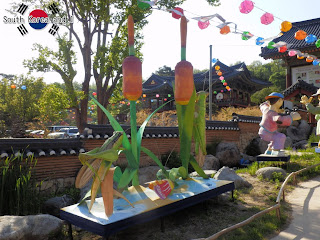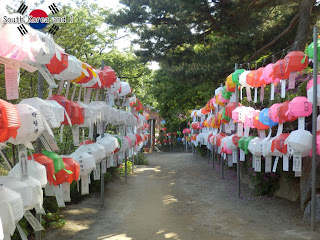According to Buddhist beliefs, lanterns symbolize wisdom in that they bring light to the world. “Yeondeung,” which means lighting lantern, is an important ritual in Buddhism gives respect to Buddha.One of the festivals' goals is to bring Koreans and international visitors together. There are a lot of stalls, where foreigners can experience traditional Korean arts, eat Korean temple food, etc. I made two lotus flowers myself, learned how to make a Hanbok Origami (traditional Korean clothing) and ate temple noodles. I also got to drink Matcha at the Japanese Buddhism stall and talked to a nice lady from Nagoya. There was also a stage, where they did games with foreigners and locals. Buddhists from Thailand or India performed a play in colorful costumes. I also got to see a traditional Korean rope dance performance (줄타기, Jultagi).
Source: http://visitkorea.or.kr/enu/SI/SI_EN_3_6.jsp?cid=1002416
I visited the lantern exhibitions at Bongeunsa Temple (봉은사) and Jogyesa Temple (조계사). It is astonishing to see all these colorful lanterns next to each other on the temple premises. People can write their wishes on papers that hang on the lanterns (but I don't know what happens with them afterwards).
In the evening I went to see the lantern parade. Hundreds of people carried or moved thousands of brightly lit lanterns in the shape of Hangul (Korean alphabet) letters, lotus flowers, elephants, dragons, Buddhas, etc. The people waiting near the road were cheering and singing. It was a great atmosphere and the lanterns were truly magnificent. Everybody put in a lot of effort into making them.
Afterwards, there was a post-parade celebration, called Hoehyang Hanmadang (회향한마당). Korean traditional singers performed for the crowed and all ended in a circle dance (강강술래, Ganggangsullae), were locals danced enthusiastically with all foreigners. During the dance small pieces of papers were blown into the air and it looked like a huge flower petal rain. It was so beautiful!
I uploaded some photos and videos for you. Please enjoy!















































































